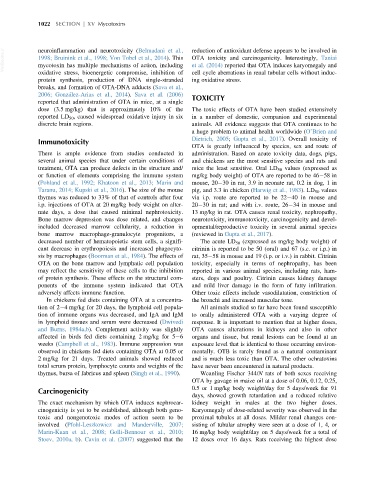Page 1090 - Veterinary Toxicology, Basic and Clinical Principles, 3rd Edition
P. 1090
1022 SECTION | XV Mycotoxins
VetBooks.ir neuroinflammation and neurotoxicity (Belmadani et al., reduction of antioxidant defense appears to be involved in
OTA toxicity and carcinogenicity. Interestingly, Taniai
1998; Bruinink et al., 1998; Von Tobel et al., 2014). This
et al. (2014) reported that OTA induces karyomegaly and
mycotoxin has multiple mechanisms of action, including
oxidative stress, bioenergetic compromise, inhibition of cell cycle aberrations in renal tubular cells without induc-
protein synthesis, production of DNA single-stranded ing oxidative stress.
breaks, and formation of OTA-DNA adducts (Sava et al.,
2006; Gonza ´lez-Arias et al., 2014). Sava et al. (2006) TOXICITY
reported that administration of OTA in mice, at a single
dose (3.5 mg/kg) that is approximately 10% of the The toxic effects of OTA have been studied extensively
reported LD 50 , caused widespread oxidative injury in six in a number of domestic, companion and experimental
discrete brain regions. animals. All evidence suggests that OTA continues to be
a huge problem to animal health worldwide (O’Brien and
Immunotoxicity Dietrich, 2005; Gupta et al., 2017). Overall toxicity of
OTA is greatly influenced by species, sex and route of
There is ample evidence from studies conducted in administration. Based on acute toxicity data, dogs, pigs,
several animal species that under certain conditions of and chickens are the most sensitive species and rats and
treatment, OTA can produce defects in the structure and/ mice the least sensitive. Oral LD 50 values (expressed as
or function of elements comprising the immune system mg/kg body weight) of OTA are reported to be 46 58 in
(Pohland et al., 1992; Khatoon et al., 2013; Marin and mouse, 20 30 in rat, 3.9 in neonate rat, 0.2 in dog, 1 in
Taranu, 2014; Kupski et al., 2016). The size of the mouse pig, and 3.3 in chicken (Harwig et al., 1983). LD 50 values
thymus was reduced to 33% of that of controls after four via i.p. route are reported to be 22 40 in mouse and
i.p. injections of OTA at 20 mg/kg body weight on alter- 20 30 in rat; and with i.v. route, 26 34 in mouse and
nate days, a dose that caused minimal nephrotoxicity. 13 mg/kg in rat. OTA causes renal toxicity, nephropathy,
Bone marrow depression was dose related, and changes neurotoxicity, immunotoxicity, carcinogenicity and devel-
included decreased marrow cellularity, a reduction in opmental/reproductive toxicity in several animal species
bone marrow macrophage-granulocyte progenitors, a (reviewed in Gupta et al., 2017).
decreased number of hematopoietic stem cells, a signifi- The acute LD 50 (expressed as mg/kg body weight) of
cant decrease in erythropoiesis and increased phagocyto- citrinin is reported to be 50 (oral) and 67 (s.c. or i.p.) in
sis by macrophages (Boorman et al., 1984). The effects of rat, 35 58 in mouse and 19 (i.p. or i.v.) in rabbit. Citrinin
OTA on the bone marrow and lymphatic cell population toxicity, especially in terms of nephropathy, has been
may reflect the sensitivity of these cells to the inhibition reported in various animal species, including rats, ham-
of protein synthesis. These effects on the structural com- sters, dogs and poultry. Citrinin causes kidney damage
ponents of the immune system indicated that OTA and mild liver damage in the form of fatty infiltration.
adversely affects immune function. Other toxic effects include vasodilatation, constriction of
In chickens fed diets containing OTA at a concentra- the bronchi and increased muscular tone.
tion of 2 4 mg/kg for 20 days, the lymphoid cell popula- All animals studied so far have been found susceptible
tion of immune organs was decreased, and IgA and IgM to orally administered OTA with a varying degree of
in lymphoid tissues and serum were decreased (Dwivedi response. It is important to mention that at higher doses,
and Burns, 1984a,b). Complement activity was slightly OTA causes alterations in kidneys and also in other
affected in birds fed diets containing 2 mg/kg for 5 6 organs and tissue, but renal lesions can be found at an
weeks (Campbell et al., 1983). Immune suppression was exposure level that is identical to those occurring environ-
observed in chickens fed diets containing OTA at 0.05 or mentally. OTB is rarely found as a natural contaminant
2 mg/kg for 21 days. Treated animals showed reduced and is much less toxic than OTA. The other ochratoxins
total serum protein, lymphocyte counts and weights of the have never been encountered in natural products.
thymus, bursa of fabricus and spleen (Singh et al., 1990). Weanling Fischer 344/N rats of both sexes receiving
OTA by gavage in maize oil at a dose of 0.06, 0.12, 0.25,
0.5 or 1 mg/kg body weight/day for 5 days/week for 91
Carcinogenicity
days, showed growth retardation and a reduced relative
The exact mechanism by which OTA induces nephrocar- kidney weight in males at the two higher doses.
cinogenicity is yet to be established, although both geno- Karyomegaly of dose-related severity was observed in the
toxic and nongenotoxic modes of action seem to be proximal tubules at all doses. Milder renal changes con-
involved (Pfohl-Leszkowicz and Manderville, 2007; sisting of tubular atrophy were seen at a dose of 1, 4, or
Marin-Kuan et al., 2008; Golli-Bennour et al., 2010; 16 mg/kg body weight/day on 5 days/week for a total of
Stoev, 2010a, b). Cavin et al. (2007) suggested that the 12 doses over 16 days. Rats receiving the highest dose

